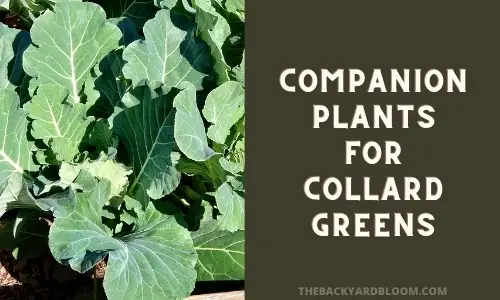Collard Greens, part of the Brassica family, is a cool-weather and frost-resistant crop that needs full sunlight to thrive. Collards are susceptible to infestation from harmful pests such as Cabbage Loopers, Aphids, and Harlequin Bugs. Using companion planting can help combat pests from overtaking your crop and help your collard greens thrive in your garden.
In this article, we go over what are good companion plants for collard greens and what not to plant with collard greens.

Good Companion Plants for Collard Greens
- Catnip
- Dill
- Marigolds
- Mint
- Mustard Greens
- Hysop
- Rosemarry
- Thyme
Catnip can be a good companion plant for collard greens because it repels a wide array of insects such as aphids and cabbage loopers.
Dill and Mint are other herbs that can help repel cabbage loopers and attract pollinators. Keep these herbs in a pot near your crop as they both can overtake areas easily.
Marigolds can be planted as a border to help keep pests away from collards. If you do use marigolds as a companion plant for collard greens, you will probably have to plant marigolds several times during the growing seasons.
Mustard Greens are commonly used as a trap crop with collard greens. Mustard greens will attract the Harlequin bug to itself so your collard greens can avert an infestation. You would plant the mustard greens as a border around your collards.
Rosemary can help keep harmful insects away from the area and nearby crops.
Thyme’s ability to repel insects can help collard greens by deterring harmful pests such as the cabbage moth.
What Not to Plant with Collard Greens
- Broccoli
- Brussels Sprouts
- Cabbage
- Cauliflower
- Leeks
- Kale
- Kohlrabi
- Pumpkins
- Strawberries
Broccoli, Brussels Sprouts, Cabbage, Cauliflower, Kale, and Kohlrabi are all a part of the Brassica family. Since they are in the same family as collard greens they can attract the same harmful pests and disease, causing all of the crops to easily be overrun. These crops will also all compete for the same nutrients which can cause issues with their ability to grow well.
Lettuce should not be used as a companion for collards. The roots of plants in the Brassica family secrete chemicals that can prevent lettuce from growing well.
Leeks compete for the same nutrients in the soil when planted with collard greens which can lead to stunted growth of both crops.
Pumpkins have large leaves that can cast too much shade.
Strawberries attract aphids which are also attracted to collard greens. These should not be planted together or you could be facing an uncontrollable infestation of aphids.
Collard Green Companion Plants Frequently Asked Questions
No, you should not plant collards and cabbage together. Since they are in the same family of plants they attract the same pests and diseases. In addition to pests and diseases, they also will compete for the same nutrients in the soil. Plant cabbage and collards in separate areas of your garden.
No, you should not plant collards and kale together. Just like with cabbage, kale and collards are in the same family. They would be competing for the same nutrients and attracting the same pests, making your garden more susceptible to crop damage from the pests.
No, you should not plant lettuce and collards together. The plants of collards have secretions that prevent lettuce (especially lettuce seeds) from growing well.